




Last summer, asked the leadership of the Division of Biology and Medicine to look closely at our mission statement. Did it reflect our present focus and goals?
Did it serve not only the needs of our own faculty, students, and staff, but also our community, both locally and globally? Are we planning, working, and strategizing every day guided by our stated mission?
What I was really asking this group of engaged leaders is, do we have a mission statement or are we on a mission?
After some thoughtful debate and discussion, we revised our mission statement to express more succinctly who we are and what we aim to accomplish.
The mission of the Division of Biology and Medicine at Brown University is to advance knowledge and the health and well-being of people and planet .

In this Dean’s Report, you will learn more about the initiatives and activities we have engaged in to advance this mission, such as:
• creating a new center focused on RNA biology;
• strengthening our affiliation with a key health system;
• expanding connections in our community;
• building a facility to integrate life sciences research;
• supporting wellness and belonging across the Division.
These efforts are interconnected and interrelated. Success in one area is not enough; we need investment across all areas to achieve our mission.
Integrating life sciences at Brown needs leading scientists who have the freedom to innovate and collaborate with peers. Our educational curriculum needs strong clinical affiliations where students can learn at the side of leading clinicians. To fulfill our mission, we need to invest in all facets of our biomedical ecosystem.
We’re all in on this noble mission. We hope you’ll join us.

MUKESH K. JAIN, MD Senior Vice President for Health Affairs Dean of Medicine and Biological Sciences
SECTION 1.2
What unites the Program in Biology,
The Warren Alpert Medical School, and the affiliated hospitals together is a shared mission to have an impact on the world around us.
– MUKESH K. JAIN, MD
in education, research, clinical care, and community engagement requires the full complement of our biomedical ecosystem to work together.
Basic science discoveries from our labs are tested by clinicians and physicianscientists in our affiliated teaching hospitals. These real-world settings help researchers refine their hypotheses and ensure that their work will have benefit for all patients. Add to that the expertise from other parts of Brown, like the School of Engineering, and we are unstoppable.
The greater alignment in our efforts is only just beginning to pay off in terms of new research programs, greater investment in commercialization of technology, and strategic recruitment of faculty and leaders who can help us move forward.
To create a learning and research environment where all people feel that they belong.
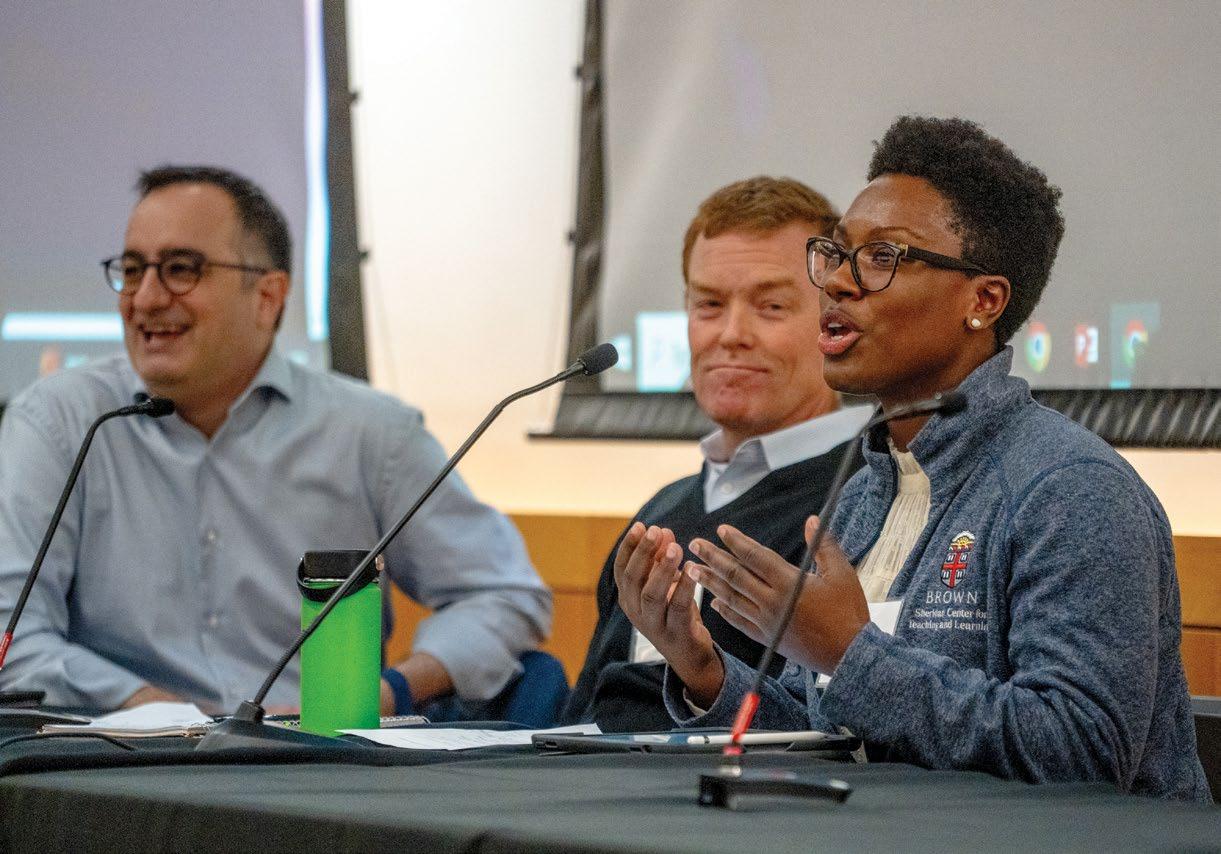
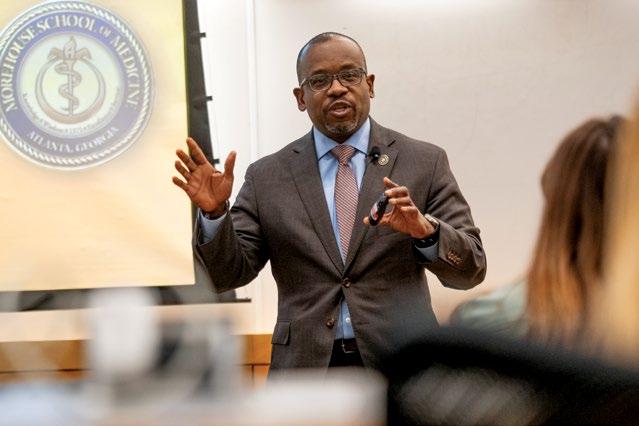
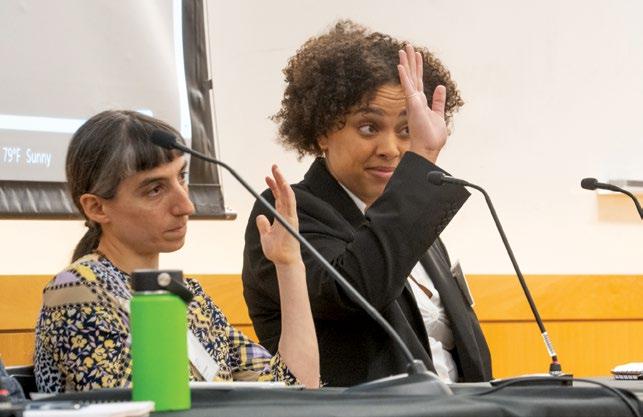
Our mission is to advance the health and well-being of all people. That means combating racism in medicine; addressing health care inequity; and building a health care workforce composed of people who look like the communities they serve. It means creating a learning and research environment where individuals feel that they are included and they belong. When people are able to bring their whole selves to their work, they bring their best selves.
In October, Brown hosted Antiracism and Diversity, Equity, and Inclusion in STEMM (science, technology, engineering, math, and medicine), a daylong conference unpacking the National Academy of Sciences, Engineering, and Medicine’s report of the same name. Joan Y. Reede ’77, MD, MS, MPH, MBA, the dean for diversity and community partnership at Harvard Medical School, presented the report’s recommendations to break down barriers and create sustainable change at institutions.
A steering committee composed of representatives of STEMM fields at Brown and chaired by Patricia Poitevien ’94 MD’98, MSc, senior associate dean for diversity, equity, and inclusion, planned the event. Poitevien opened the conference and served as a panelist during a session on antiracist and DEI strategies for graduate students.
When people are able to bring their whole selves to their work, they bring their best selves. ” ‟
Faculty led panel discussions addressing antiracist and DEI strategies, and speakers highlighted existing efforts to increase diversity not only now but in the future by creating pathway programs for young people.
“The day was energizing,” Poitevien says. “We were able to bring together DEI champions and stakeholders invested in STEMM from all facets of our Brown community— undergraduate and graduate campuses, educators and researchers, students, faculty, administrators, and alums— to think critically about how we can advance antiracism, diversity, equity, and inclusion across Brown.”
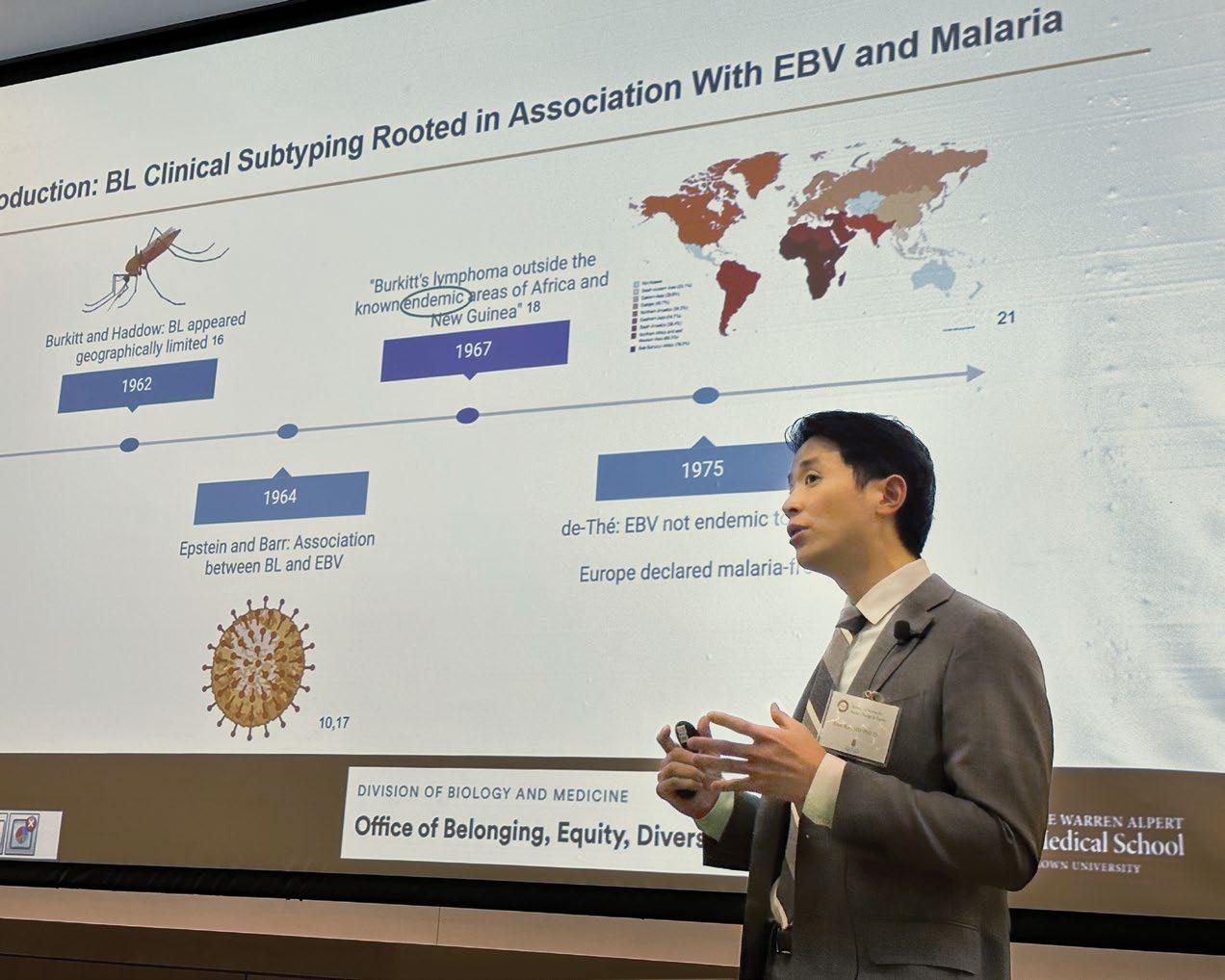

The Brown Advocates for Social Change and Equity (BASCE) program prepares Medical School faculty, trainees, and students to lead social justice, health equity, and anti-racism efforts in health care—at Brown and beyond.
Anne Vera Cruz, PhD, assistant dean for curriculum on diversity, inclusive teaching, and learning, leads the yearlong program. She supports each fellow as they plan and implement curricula and research projects designed to improve patient care and eliminate health disparities.
“The goal of BASCE is to create changemakers,” Vera Cruz says. “What we’re trying to do here is to improve health care for everyone.”
SAFE SPACE FOR HONEST CONVERSATIONS
As BASCE fellows hail from different class years, hospitals, specialties, and career stages, Vera Cruz cultivates each cohort to build rapport and trust. Franklin Iheanacho MD’25 says the group’s diversity “helps you see a different point of view. How do people see race? How do people see certain topics within critical race theory? I’m learning a lot from them.”
But they all have one thing in common, adds Zain Khalid, MD, an assistant professor of psychiatry and human behavior. “They’re also kind of restless. They want to effect some sort of change,” he says. “BASCE gives us an avenue to channel that into a common purpose.”
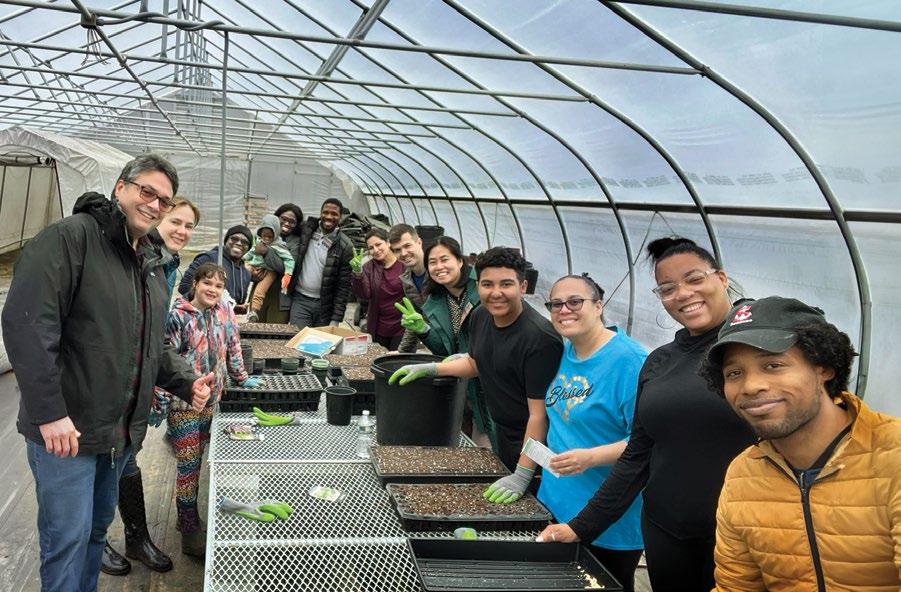
The Brown Justice, Equity, Diversity, and Inclusion Faculty Association (JEDI FA) set sail on Narragansett Bay with the Bristol Yacht Club last fall.
The spectacular day on the Bay was part of the Let's Get Outside series, launched by the Center for Workforce Recruitment and Retention to encourage members of JEDI FA to get outside of their routines—and to expand and explore places where those with a history of marginalization have not always had access or were told they do not belong.
Participants felt rejuvenated—and included. As faculty of color, they said they now feel welcome to access the beauty of being on the water; several even expressed interest in sailing lessons. Thanks to the overwhelming success, JEDI FA will sail again with the Bristol Yacht Club in September 2024 and make this an annual event.
In April, Let’s Get Outside took JEDI FA members far from the water to dig in the dirt. During the volunteer day at Bami Farm, a six-acre community farm run by the African Alliance of Rhode Island, faculty helped with various tasks, learned about the benefits of community farming, and got their hands dirty.
Misidentifying or mispronouncing someone’s name— even inadvertently—can send a subtle message that that person doesn’t belong.
The “My Name Is” Campaign aims to help prevent name- and identity-based microaggressions by raising awareness of the importance of pronouncing names correctly and using preferred pronouns.
While the campaign, launched this year by the Office of Student Affairs and the Center for Student Belonging, was designed with students in mind, it applies to colleagues, patients—anyone you meet. Assistant deans Rory Merritt, MD, and Dioscaris Garcia PhD’12 produced a series of videos featuring community members talking about the significance of their names and created a tip sheet of best practices and mistakes to avoid related to a person’s name or pronouns.
• Ask for a person’s name and listen carefully
• Repeat the name and ask for clarification
• If needed, write it out phonetically, associate the name with a picture, phrase, or mnemonic
• Use name tags
Find more information, including the full tip sheet, at healthy-learning.med.brown.edu.
To prepare physicians and scientists for a changing world.

Participating in research can help medical students refine their career goals, prepare for competitive residencies, and broaden their understanding and knowledge of patients’ health. That’s not to mention the new perspectives and engagement that students bring to a lab or project. To facilitate medical student participation in research, The Warren Alpert Medical School appointed its inaugural director of Medical Student Research in January 2024.
Stephanie Chow Garbern F’19, MD, MPH, is an assistant professor of emergency medicine at Brown, where she completed a fellowship in global emergency medicine. She has served in multiple capacities for the Brown Division of Global Emergency Medicine, including as research coordinator, director of student internships, and co-director of the Carolan Rwanda Research Fellowship, where she has supported numerous medical, undergraduate, PLME, and public health students’ involvement in research. She is a member of the Brown Global Health Advisory
Committee and affiliated faculty of the Watson Institute for International and Public Affairs Center for Human Rights and Humanitarian Studies.
In addition to increasing participation, Garbern helps facilitate medical students’ engagement in research. She works to match them with available and appropriate mentors and provide support for students learning the research process. She also oversees the Summer Research Assistantship program, a 10-week, paid student research opportunity.
“I am looking forward to building students’ excitement, skills, and confidence in conducting research, and increasing the accessibility of research, especially for those without prior research experience,” Garbern says.
METHODS
In the Division of Biology and Medicine, students hold a unique role—they are encouraged to engage in research, to shape their curriculum, to teach as much as they learn. Increasingly, every level of training is imbued with a curriculum that trains students for the realities of their changing planet, whether it’s the research questions they pursue or how they provide care for people affected by climate change.
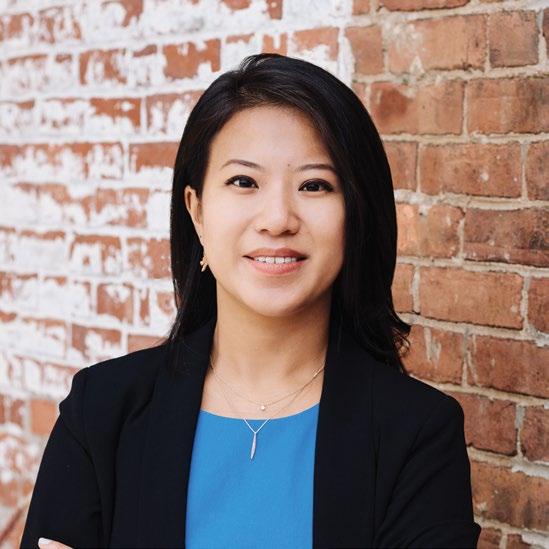
STEPHANIE CHOW GARBERN, MD, MPH Director of Medical Student Research

Medical students now can participate in a clinical elective working alongside the SMART Plus clinical team in the Calcutt Middle School-based clinic. Embedded in this Central Falls, RI, school, they identify and address physical, behavioral, social, and emotional barriers to classroom success.
SMART (School Health Model for Academics Reaching All and Transforming Lives) Plus is a school health care delivery service that identifies risks and barriers to academic success, and then delivers interventions to eliminate or mitigate those barriers, creating an environment to support learning.
“Plus” refers to the collaboration with The Warren Alpert Medical School. The medical students in this elective also will have the opportunity to work with The Warren Alpert Medical School’s afterschool program and other Pathways Programs as clinical role models for Calcutt students. These programs provide opportunities for middle school students to gain exposure to health care careers. This is the first clinic in the nation to partner with a medical school on such offerings.
The Warren Alpert Medical School has long been a leader and innovator in competency-based medical education.
Since 2011, the core competencies of the Medical School curriculum have been known as The Nine Abilities. In recent years, the Office of Medical Education saw a need to reevaluate the competencies given national trends in medical education and guidelines from accrediting bodies.
The Medical Curriculum Committee approved new competencies in March. The Six Competencies align with guidelines to facilitate a smoother transition to residency training. They are:
• Patient Care
• Medical Knowledge
• Practice-Based Learning and Improvement
• Systems-Based Practice
• Professionalism
• Interpersonal and Communication Skills
Each Competency is delineated by a group of subcompetencies that describe the knowledge and skills students will obtain prior to graduation.
Over the next two years, new assessments based on the competencies will be piloted and implemented. They will shift focus to a growth mindset-oriented model with an eye toward decreasing bias in assessments. For faculty, this new assessment framework will move toward evaluating behaviors that can be more directly observed in both clinical and classroom settings.
The Six Competencies will be rolled out gradually to each class, and the assessment framework should be in use during the 2026–2027 academic year.
The Medical School announced in August 2023 that it will no longer submit data to US News & World Report for its Best Medical Schools rankings, citing that its metrics do not comport with the School’s mission and values.
The goal is to provide future clinicians and scientists with the breadth and depth of knowledge about planetary health.
– KATHERINE F. SMITH, PHD Senior Associate Dean for Biology Education
Four doctoral students at Brown received the Howard Hughes Medical Institute’s prestigious Gilliam Fellowship for Advanced Study.
The Gilliam Fellows Program supports graduates who are committed to advancing equity and inclusion in science and empowers them as future leaders in scientific fields through financial assistance for three years of doctoral research. It also supports faculty thesis advisers to enhance their mentorship skills and ability to develop more inclusive training environments.
Brown is fortunate to have four current fellows: Amanda Elyssa Ruiz PhD’24, Myles Bartholomew PhD’26, Mayra Bañuelos PhD’26, and Joseph Aguilera ScM’26 PhD’26. To date, 10 Brown students have received Gilliam fellowships;
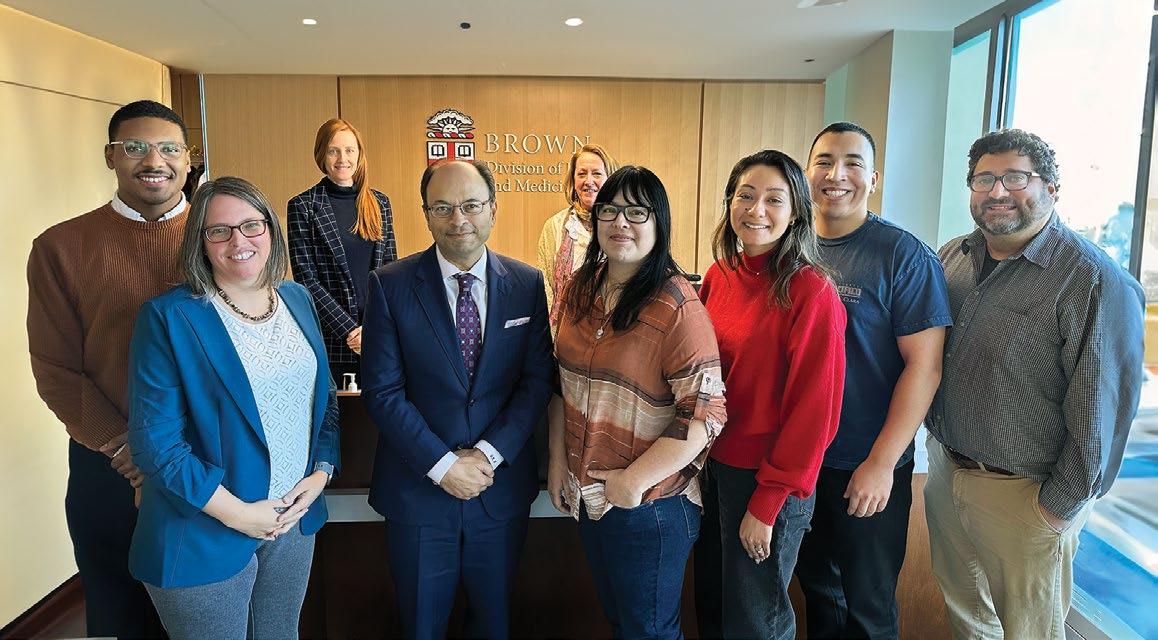
having four fellows at the same time recognizes the University’s outstanding research and dedication to advancing inclusivity across the scientific community.
The fact that the health of humans is inextricably linked to the health of the planet has given rise to a multidisciplinary field called planetary health. Throughout the Division of Biology and Medicine, faculty and students are coming together to ensure students in all cohorts, from the undergraduate college to the Medical School, have access to planetary health education.
Efforts to date include a formal commitment to longitudinally integrate it throughout the medical curriculum, implementation of a planetary health scholarly theme in the Health & Human Biology undergraduate
concentration, and online asynchronous course offerings in planetary health accessible to undergraduates studying in any scholarly discipline.
“The goal,” says Katherine F. Smith, PhD, senior associate dean for biology education, “is to provide future clinicians and scientists with the breadth and depth of knowledge about planetary health, particularly how it is relevant to all of the systems of the body and the diseases they may be treating or trying to find cures for.”

MARCUS-WADE ’25 was named a Maria L. Caleel ’87 Memorial Undergraduate Biology Research Fellow.

JUDY JANG ’03 MD’07 began her tenure as associate dean for the Program in Liberal Medical Education in February 2024.


To
advance our
understanding of cancer, aging and aging-related disease, brain health, immunology, and more.
METHODS
In the Division of Biology and Medicine, we have all the players in the cycle of discovery, from basic science to clinical application to population-level evaluation. And we have strong partners in Brown’s School of Engineering and School of Public Health, and the affiliated health systems to complete that cycle of translation to impact real people.
Dean Mukesh K. Jain, MD, came to Brown in 2022 determined to establish a center for RNA research.
Ribonucleic acid is found in all living cells, and is known to play a role in some of humanity’s most challenging diseases, including several cancers, flu, Alzheimer’s, and spinal muscular atrophy. Most famously, messenger RNA was a vital component of the lifesaving COVID-19 vaccines that more than 70 percent of the world’s population has received. Understanding RNA can also benefit agriculture, industry, even biosecurity. “COVID was just the tip of the iceberg,” Jain says.
Last year his plans came to fruition. Juan Alfonzo, PhD, a world-renowned RNA biologist, arrived at Brown in July and, in October, became the inaugural executive director of the new Brown RNA Center. Members include a number of existing faculty members from across the University with
expertise in biology, genetics, chemistry, and engineering, as well as several new recruits. Most of their labs are housed together in the Jewelry District, where, Alfonzo says, they can more easily work together.
So much about RNA remains a mystery even to experts, because the technology to accurately sequence it does not exist. Alfonzo helped write a National Academies of Science, Engineering, and Medicine committee report calling for a plan to develop that technology. Brown also hosted the first international working group meeting to sequence all of our RNA, in all of its forms, in January 2024. Jain says Rhode Island can play a key role in the future of RNA science: “This is one of the largest scientific endeavors since the Human Genome Project.”
The Brown Innovation and Research Collaborative for Health, or BIRCH, is coalescing as an administrative structure that brings research conducted by the Division of Biology and Medicine, Lifespan Health System, and Care New England under one administrative umbrella. The overarching goal for BIRCH is to align the organizations’ biomedical and health sciences research activities to support research growth and innovation. BIRCH will improve the researcher experience, attract patients, recruit and retain diverse, top-class faculty and staff, streamline administrative support, and address barriers to growth.
Since the appointment of Francie Emlen, MBA, RN, as its chief administrative officer and Bharat Ramratnam, MD, as chief scientific officer last summer, teams from all three organizations have been immersed in establishing the financial, operational, and administrative structures that are entailed in such a complex organization. The hard work, however, is well worth it.
“It’s exciting to see the pieces come together,” Emlen says. “The work has been incredibly collaborative and collegial. We are all united around a shared end goal, and even when we’re buried in spreadsheets and reports, we never lose sight of why we’re doing this and what it will mean for our institutions.”
Follow BIRCH’s progress at birch.brown.edu.
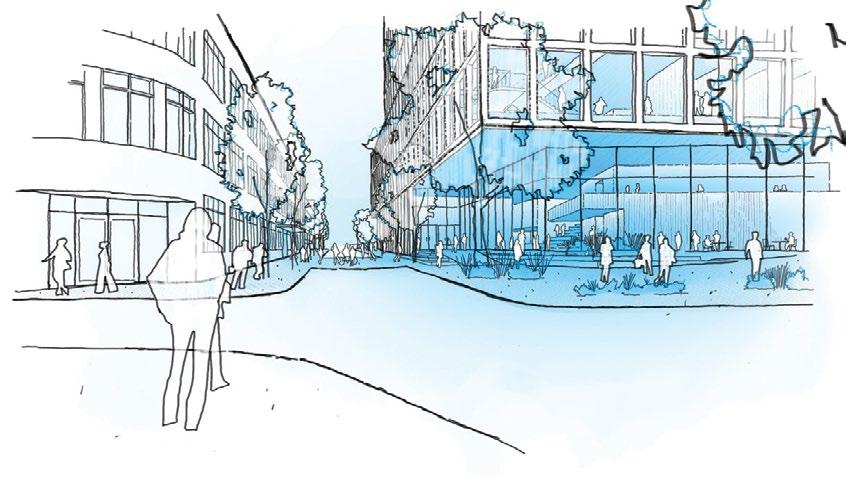
approved the design of a new facility for integrating life sciences research at Brown in February. Site preparation of its Jewelry District location began in summer 2024, with completion expected in 2027.
The following faculty joined the Program in Biology in 2023.

FEDERICA ACCORNERO, PHD
George D. Eggleston Associate Professor of Biochemistry
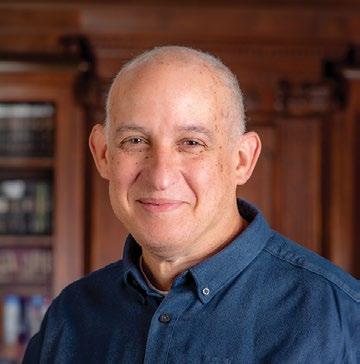
JUAN ALFONZO, PHD
Professor of Molecular Biology, Cell Biology, and Biochemistry; Mencoff Family Executive Director of the Brown RNA Center
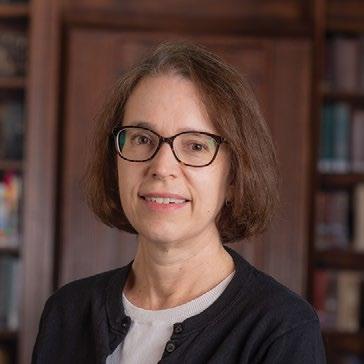
CHRISTINA CUOMO, PHD
Viatris Professor of Molecular Microbiology and Immunology

KARTHIKEYANI CHELLAPPA, PHD
Basaviah-Ganesan Family
Assistant Professor of Molecular Microbiology and Immunology
$6.2M VA Research Is Poppin’
The Providence VA Healthcare System saw a number of large grant renewals and new awards this year. Here’s a sampling of $1-million+ awards.
Renewal grant for the Center for Neurorestoration and Neurotechnology
LEIGH HOCHBERG, MD, PHD
L. Herbert Ballou University Professor of Engineering, Professor of Brain Science
BENJAMIN GREENBERG, MD, PHD Professor of Psychiatry and Human Behavior
$301.5M
DIVISION’S TOTAL SPONSORED RESEARCH ACTIVITY (CAMPUS + HOSPITALS)
$4.4M $2.3M $1.1M
Renewal grant for the CardioPulmonary Vascular Biology Center of Biomedical Research Excellence
GAURAV CHOUDHARY, MD
Ruth and Paul Levinger Professor of Cardiology
ELIZABETH HARRINGTON, P H D Professor of Medicine
Rapid Neural Typing Interface for Veterans with ALS
LEIGH HOCHBERG, MD, PHD
L. Herbert Ballou University Professor of Engineering, Professor of Brain Science
CardioPulmonary Vascular Biology COBRE Team Science Supplement Project
GAURAV CHOUDHARY, MD
Ruth and Paul Levinger Professor of Cardiology
PENG ZHANG, MD
Assistant Professor of Medicine

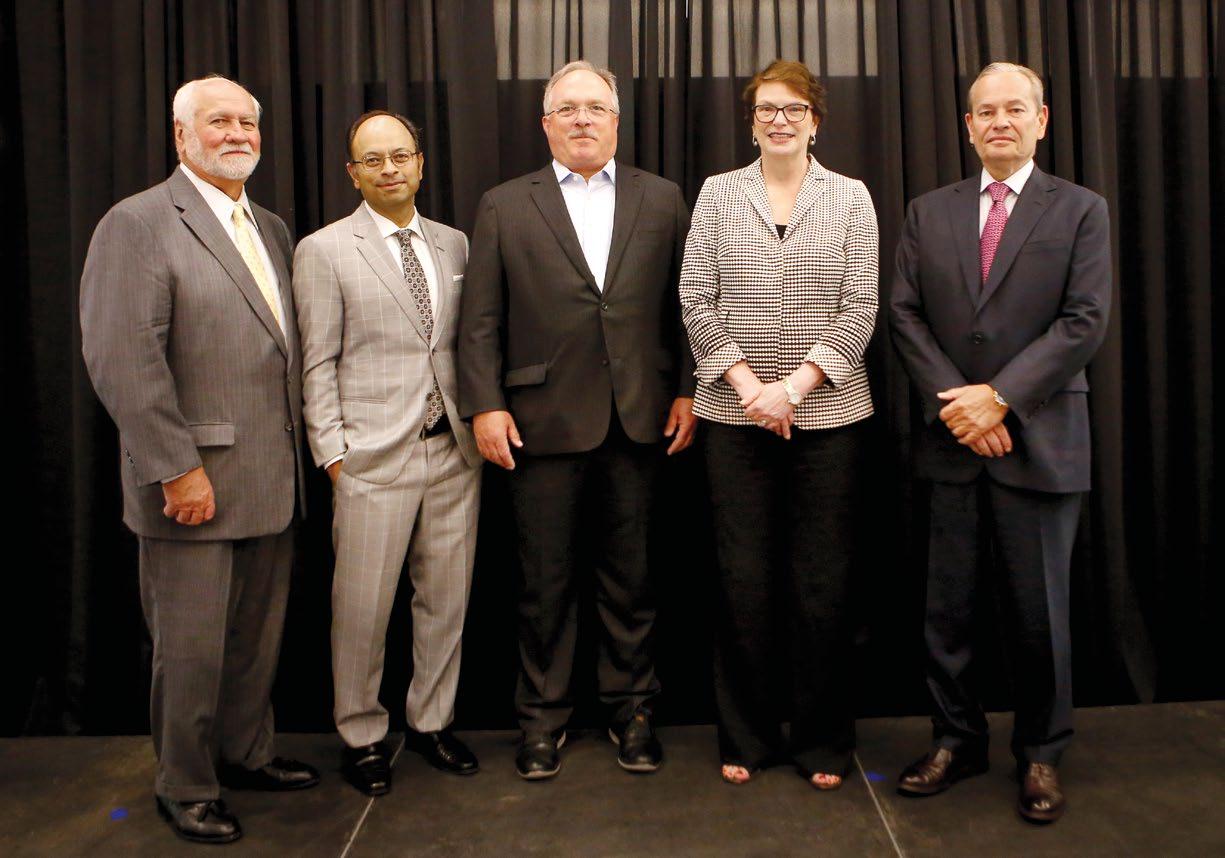
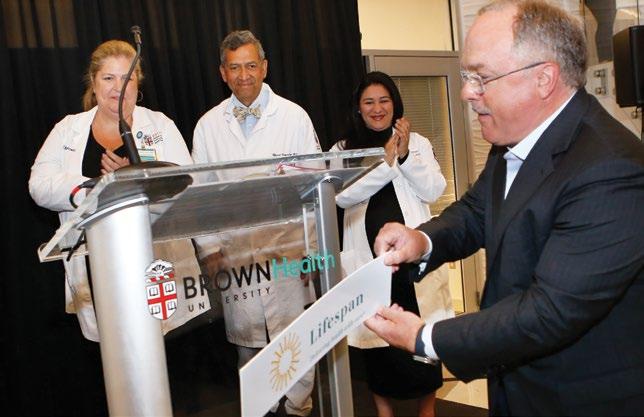
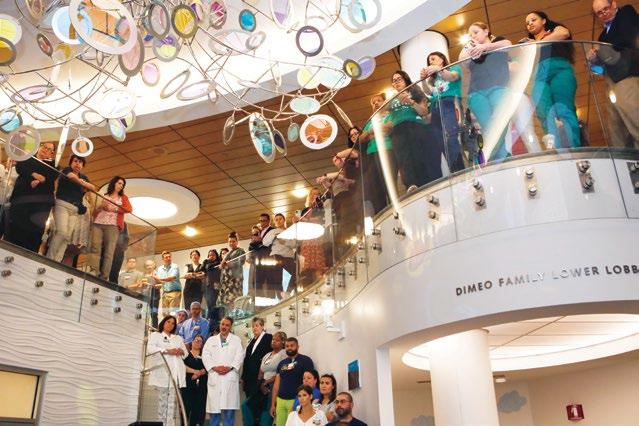
METHODS
The lives of people in Rhode Island are in the hands of Warren Alpert Medical School faculty. They work to bring the most cutting-edge treatments to those who need them, often while pursuing lab research and clinical trials that drive the development of those therapeutics. Our faculty are also fierce advocates for their patients, taking their issues and concerns to the State House and Capitol Hill, from reproductive health to the effects of climate change on well-being. At the same time, clinical care is focused on improving health care access and equity.
After five decades of affiliation, Lifespan Health System and Brown announced a set of expanded affiliation agreements that will strengthen top-quality patient care, medical education, and biomedical research in Rhode Island. As part of the agreements, Lifespan will change its name to Brown University Health, enhancing its ability to recruit and retain world-class physicians and reflecting a deeper alignment between Lifespan’s clinical care and Brown’s academic and research focus.
“Brown and Lifespan are taking important steps to strengthen our longstanding affiliation with the goal of improving the health of families in Rhode Island, both through medical advances in care and state-of-the-art medical training for the next generation of physicians,” Brown University President Christina H. Paxson says.
INVESTMENTS IN ACADEMIC MEDICINE
The agreements include reciprocal financial investments between Lifespan and Brown, which will continue as separate, independent organizations. A $15 million to $25 million annual investment from Brown to Lifespan, totaling $150 million over seven years, will be devoted to strengthening Lifespan’s financial capacity to sustain and advance the shared academic mission of the two organizations. Following that period, Lifespan will invest $15 million annually to support The Warren Alpert Medical School’s education and research efforts, similar to arrangements found at other medical schools in the US.
LINDA BROWN , MD, MSCE, became chair of emergency medicine.
Brown RES’00 is also the physicianin-chief of emergency medicine for Rhode Island, Hasbro Children’s, The Miriam, and Newport hospitals; president of Brown Emergency Medicine; the Frances Weeden Gibson-Edward A. Iannuccilli, MD, Professor of Emergency Medicine; and a professor of pediatrics.
MAHESH JAYARAMAN , MD, became chair of diagnostic imaging.
Jayaraman ’94 MD’98 RES’03 is also the Charles and Elfriede CollisFrances Weeden Gibson Professor of Diagnostic Imaging; a professor of neurology and of neurosurgery; chief of diagnostic imaging at Lifespan; and director of the Neurovascular Center at Rhode Island Hospital.
AUDREY TYRKA , MD, PhD, became chair of psychiatry and human behavior.
Tyrka RES’03 is also the Mary E. Zucker Professor in Psychiatry and Human Behavior; founding co-director of the Initiative on Stress, Trauma, and Resilience at Brown; and founding director of the Laboratory for Clinical and Translational Neuroscience at Butler Hospital.
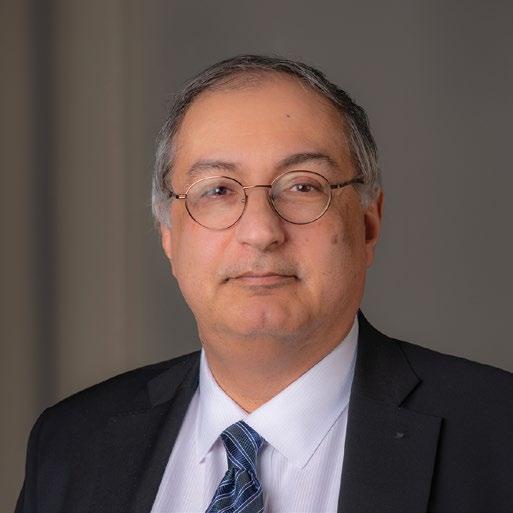
WAFIK EL-DEIRY, MD, PHD
The National Academy of Inventors named El-Deiry to its 2024 class of Senior Members. He is the director of the Legorreta Cancer Center, associate dean for oncologic sciences, and Mencoff Family University Professor of Medical Science.

METHODIUS TUULI , MD, MPH, MBA
Tuuli was elected to the National Academy of Medicine in October 2023. He is the Chace-Joukowsky Professor and chair of obstetrics and gynecology at Brown and the chief of obstetrics and gynecology at Women & Infants Hospital.
A clinical innovation at the VA improves care for the neediest patients.
At the VA Providence Healthcare System, the Geriatrics and Extended Care Division launched a pilot program to provide teambased integrative care called the Age-Friendly Unit. The hospital identified champions from nursing, occupational therapy, and medicine/surgery administrative staff to join this special inpatient unit for elderly, high-risk, and high-need patients. The pilot is a departure from the practice of assigning veterans, irrespective of age and need, to a provider team that may create a onedimensional, acute-problem-focused care plan without input from other health care professionals or family—or what matters the most to the patient.
The Age-Friendly Unit Pilot became a joint program of Geriatric and Palliative Medicine, Hospital Medicine, Nursing, and Occupational Therapy, says AnnMarie Dunican, MD, chief of staff at VA Providence and an associate professor of medicine at Brown. The team provides “interdisciplinary consult recommendations by systematically addressing medications, mobility, mentation, and what matters most to patients,” she says.
The approach is working, Dunican adds: “Our preliminary results indicate improvements in the 30-day rate of readmissions and mortality, with more patients going home versus an institution.”

Brown University staff member Rochelle Ives is one of the Rhode Islanders who share their experiences as cancer survivors in a new series of short films called Color of Cancer. The project, spearheaded by Sheldon D. Holder, MD, PhD, associate director for diversity and inclusion at the Legorreta Cancer Center, is part of an effort to better serve people with cancer from minoritized and underserved communities.
Katelyn Moretti F’20, MD, MS, an assistant professor of emergency medicine, testified at a congressional budget hearing last year about the effects of climate change, such as longer, hotter temperatures, on human health.
METHODS
In order to advance the health and well-being of our community, we must deliberately and intentionally engage with Rhode Islanders across the state. We do this through programs that educate younger children and adolescents about careers in health care and science, by supporting community health workers, and by forging meaningful relationships with other organizations that serve communities.

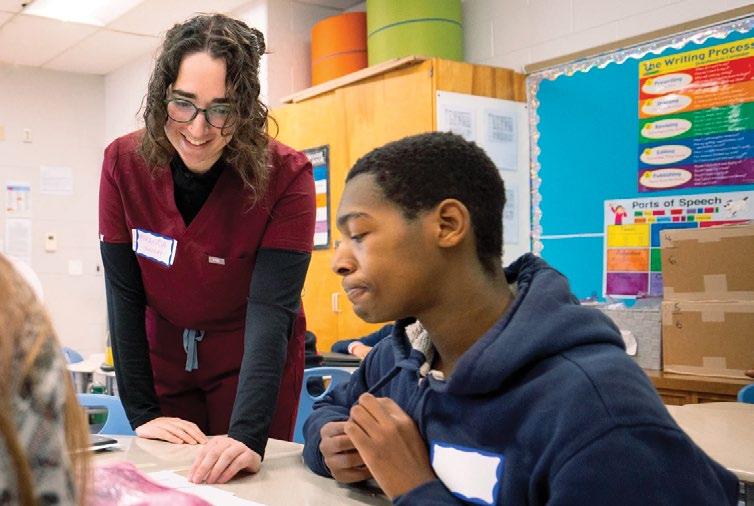
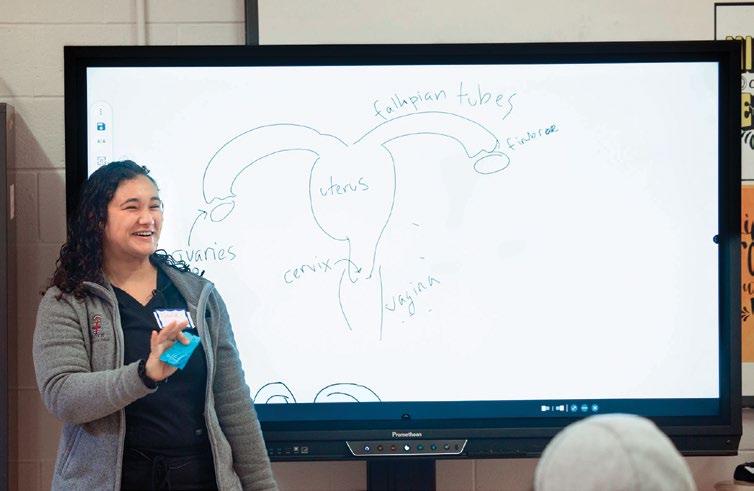
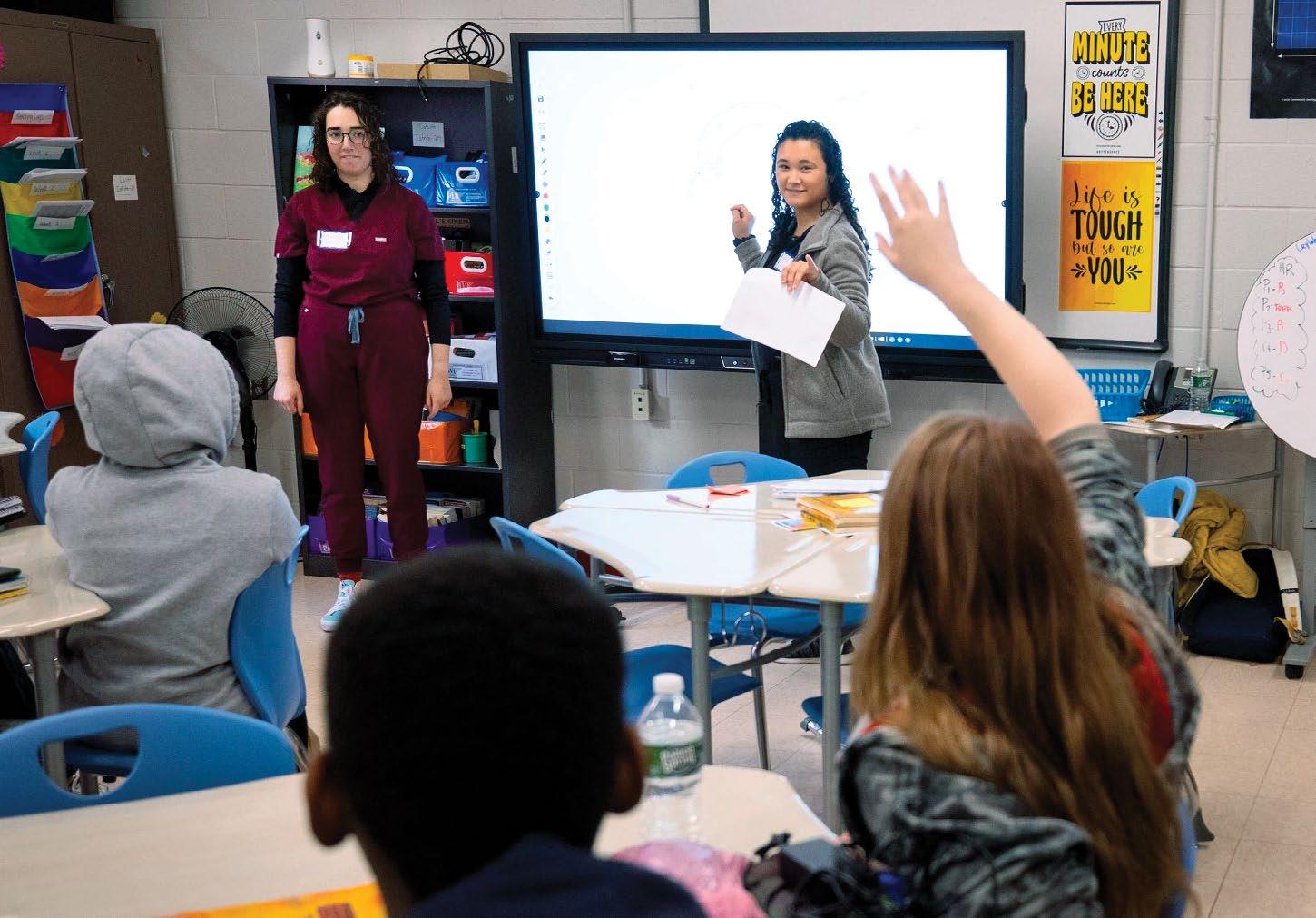
For 10 years, Warren Alpert medical students have taught sex education in Central Falls, which has one of the highest teen pregnancy rates in Rhode Island.
Through the pre-clerkship elective, first- and second-year students offer lessons to about 200 middle schoolers each year on such topics as reproductive anatomy, sexual decision-making, contraception, pregnancy, and gender identity. They emphasize that abstinence is the most effective way to prevent pregnancy and sexually transmitted infections and discuss consent, healthy relationships, and abuse.
Evaluations conducted before and after the course show big improvements in student understanding of sex ed topics. Sex Ed by Brown Med has inspired similar initiatives at other medical schools, and it’s looking to expand to other Rhode Island districts as well, with the help of outside volunteers.
“Sex Ed by Brown Med isn’t just a new health class offered to kids during the day—it’s now part of the school culture,” says Susanna Magee MPH’03, MD, the elective’s faculty adviser. “It’s a culture of care, of community involvement that is now seamlessly integrated into the fabric of the school, and we’re proud of that.”
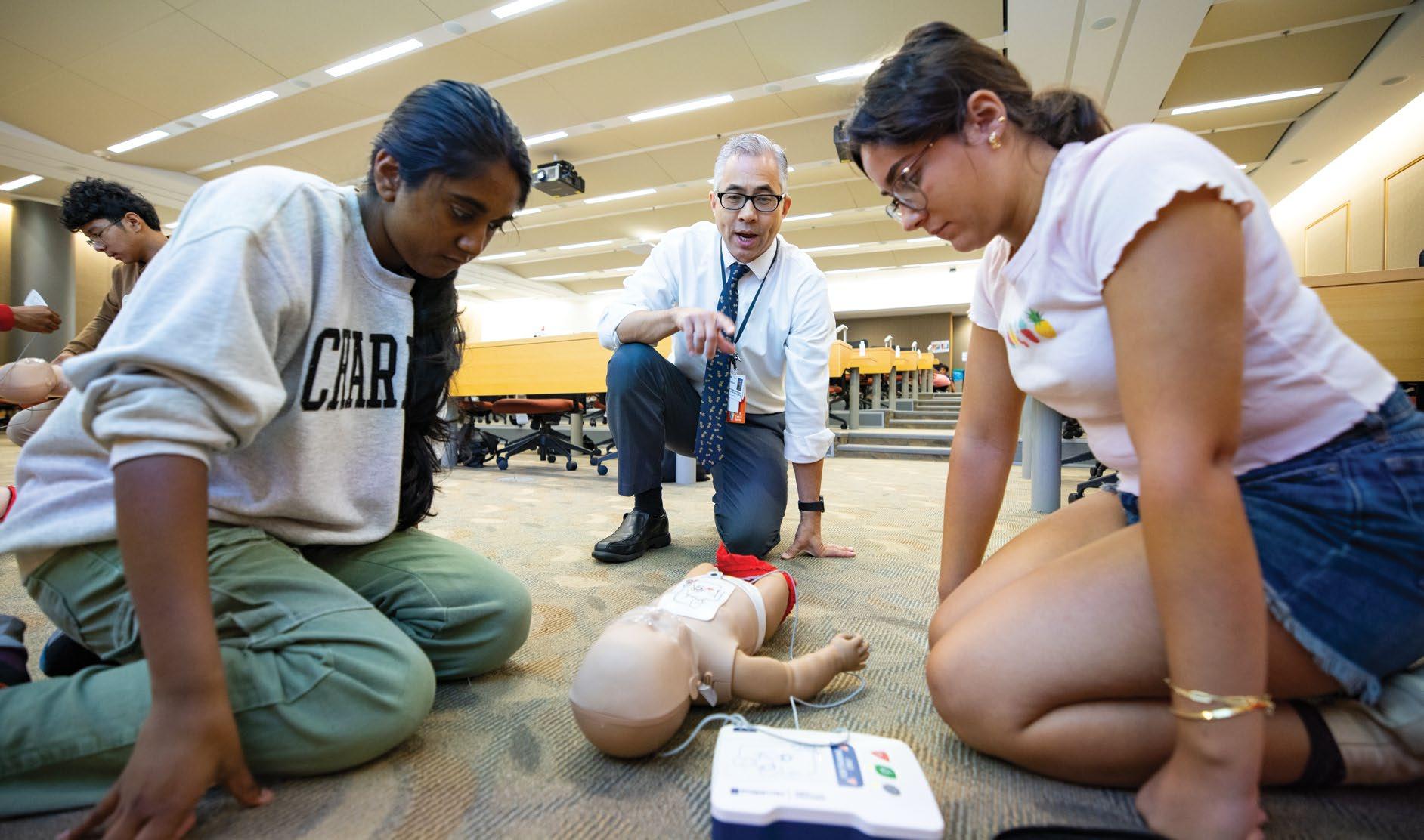
For five days each summer, local high school students became medical students, learning to take a patient’s medical history and vital signs, dissect a cow’s heart, solve patient case studies, and master basic life support skills. Week of Medicine, one of the Medical School’s Pathways Programs, offers a glimpse of what it’s like to pursue a career in medicine from workshops and mentorship to donning white coats in clinical suites and surgical gloves and scrubs in the anatomy lab.
The goal is to demystify medical education. These experiences can help the students feel more confident about taking the steps toward a career in medicine.
— LUCKSON OMOAREGBA, MS, Director of Pathways Programs
In September 2023, 100 community health workers from all over Rhode Island converged at the Medical School for a day of networking and professional development.
For six weeks each summer, more than a half-dozen local high school students intern for the Department of Pathology and Laboratory Medicine, working alongside scientists and clinicians as they learn how pathology fundamentally influences patient outcomes.
Assistant Professor of Pathology and Laboratory Medicine Jessica Plavicki, PhD, who directs the program, says Brown can play a significant role in sparking excitement among young Rhode Islanders for careers in a biomedical field that they might not have been exposed to otherwise.
Interns learn and practice various laboratory techniques, work alongside mentors to contribute to ongoing research, and rotate through different pathology subspecialties at affiliated hospitals to get a behind-the-scenes look at how pathologists analyze biopsies, surgical specimens, and autopsies.
One former intern, Ailyn Mendoza ’27, is now an undergraduate at Brown who wants to study how microorganisms infect the human body. “The internship showed me how research and the medical field are linked and that they’re essential to one another,” Mendoza says.
Each April, dozens of pre-med students from across Rhode Island and beyond gather at the Medical School to prepare for the next steps of their medical education.
Over two days, participants in On the Horizon learn about the medical school application process, financial aid, and preparing for the MCAT exam. Participants also meet current Warren Alpert Medical School students, staff, and faculty to ask questions and get advice.
On the Horizon is hosted by the Student National Medical Association and Latino Medical Student Association in partnership with the Office of Belonging, Equity, Diversity, and Inclusion.
We are on a mission to care for those who care for others.
Under the direction of our chief wellness officer, the health and well-being of our faculty, students, and staff is factored into decision-making and policy setting. Listening to the needs and problems voiced by members of the Division, our leadership is working toward making changes that improve and sustain wellness.
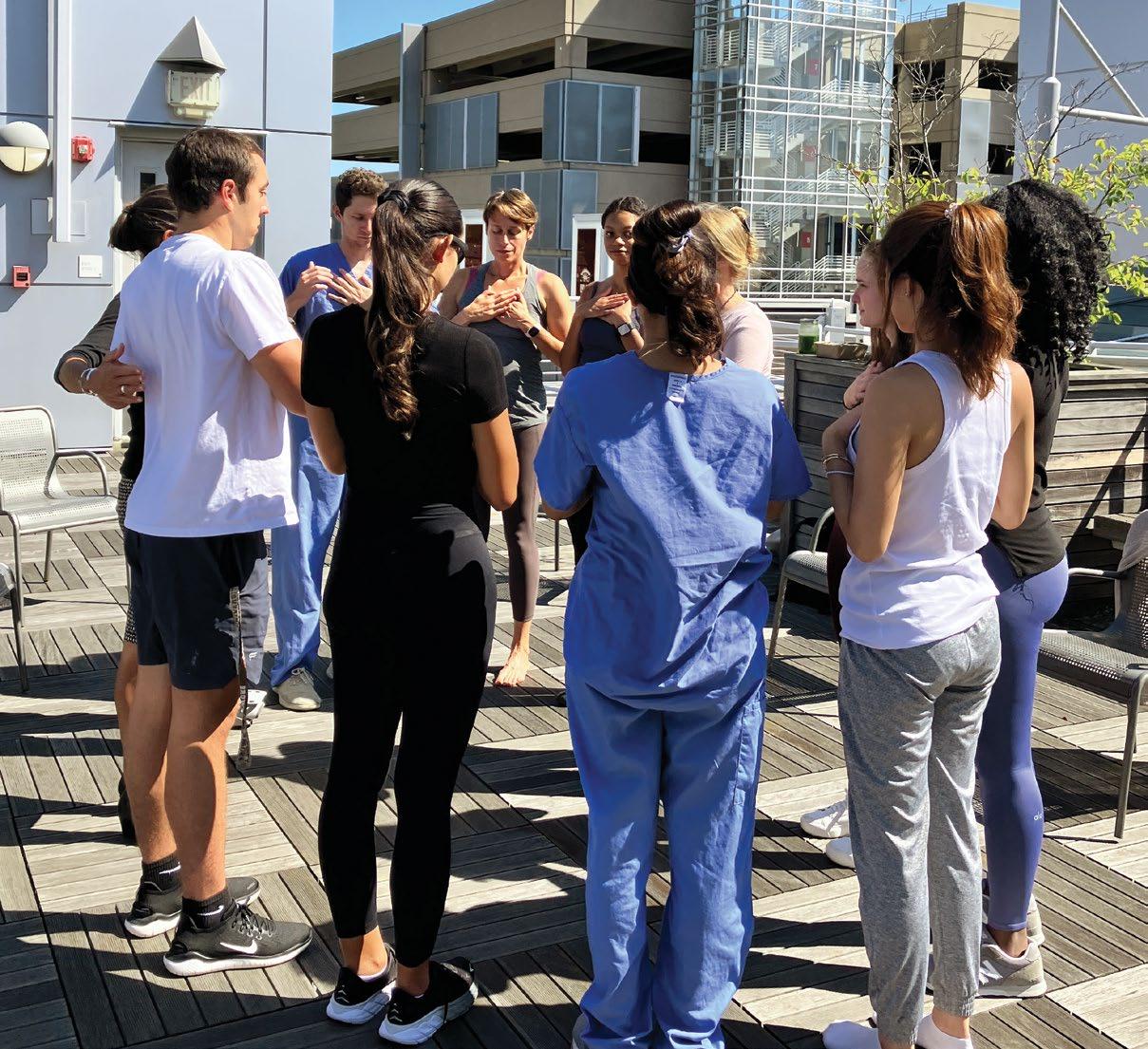


This year the Medical School piloted Doctoring Skillfully, a nine-week course that equips medical students and physicians with tools to navigate the joys and challenges of practicing medicine. Participants learn to manage stress, regulate emotions, communicate empathetically, and advocate for change, while connecting with peers to share wisdom and find support.
Now in its second year, Buddies Peer Support offers virtual drop-in sessions for learners transitioning from medical school to residency. Mentees can connect with peers, receive guidance from senior resident mentors, and support from well-being leaders. These weekly sessions provide a supportive space to share experiences and build a sense of community during this pivotal transition.
The statistics are sobering: one in four medical students reports symptoms of depression; up to 400 physicians die by suicide each year. Chief Wellness Officer Kelly Holder, PhD, brought these taboo topics into the light at the Medical School’s first-ever conference to raise awareness of suicide in health care, with the theme “We’re Talking About It.”
“This is a hard topic,” Holder said. “I’m hoping that not only do people leave inspired and think about the things they want to do in their own areas, but they will continue to have these conversations and push for advocacy and change that we need to make our community safer.”
Two attendees flew from California for the half-day conference: John and Jennifer Ruddell, parents of Jack Ruddell ’17 MD’21, who died by suicide in 2020. “To see the efforts underway and the changes being made,” John Ruddell said, “is the telling indicator of whether there is a real commitment to these programs and these efforts around student wellness.”
Holder says this year’s conference, on Sept. 25, will aim to move “from awareness to action” by continuing to reduce stigma through education, share resources, and provide support.
Wellness leaders from across Brown and the local health care system gathered at the Medical School in April to network, share ideas, and find ways to work together to build resilience and combat burnout.
Speakers at the inaugural Physician Well-Being Symposium offered strategies ranging from mindfulness training to narrative writing, shared their experiences building wellness programs, and encouraged everyone present to take time to care for themselves.
Kelly D. Holder, PhD, chief wellness officer for the Division of Biology and Medicine, said the goal of the event was to “reduce siloing” among like-minded people.
THE NEXT GENERATION
The presenters at the half-day symposium included several students, who spoke about the work they are doing at the
Medical School to offer peer support and integrate wellness education in the curriculum.
At the end of the day, Holder singled the students out for praise, noting, “The medical students are the ones we’re training so they can do our jobs.”
Physicians are at high risk of anxiety, depression, and burnout—and it begins in medical school. The Division has launched numerous programs to counter students’ distress, tailored to individual needs and interests.
Prescription for mindfulness:
MBAT Rx, a faculty-led mindfulness training program, offers students tools to focus on their studies, patient care, and their own well-being.
The symposium brought together folks who are passionate about well-being and sparked increased collaboration and support between departments and divisions. I believe that the solutions we’re looking for will be found within our connections and cooperation.
— KELLY D. HOLDER, PHD, Chief Wellness Officer
Active listening: The Medical School launched Wellness and Learning Environment Rounds, where administrators meet with third-year students at their clinical sites to openly discuss issues of mistreatment and other concerns.
Checking in: About half of the first-year class attend opt-out wellness checks with the chief wellness officer. The Wellness Program also offers mental health and wellness assessments, and several student peer support groups are active.
Game changer: All medical students have free access to Better Together physician coaching, offered by the University of Colorado. The program provides one-on-one and group sessions with a certified coach as well as other resources to help participants manage their busy lives and careers.
The Medical School signed on as a Change Maker Accelerator in the National Academy of Medicine’s Change Maker Campaign, pledging to make health worker well-being a long-term value by implementing priority areas of the NAM’s National Plan for Health Workforce Well-Being, a roadmap for action to address health worker burnout.
For overworked physicians exhausted by demanding schedules and clinical tasks, a virtual training program may help them revitalize their practice and rediscover the joys of medicine. RechargeMD helps physicians identify unhealthy habits and gain new skills to support their well-being and improve patient interactions—and their own career satisfaction. After completing the short course, which includes weekly online training sessions and support groups, physicians report a marked decrease in anxiety and burnout, along with greater self-compassion.

The Warren Alpert Medical School Food Cupboard, on the second floor of the Medical School building, provides ready-to-eat and easyto-prepare snacks and meals to those in need. All are welcome.
Our
mission is shared and advanced
by the generous alumni, parents, and friends who are part of this community.
Support from our community furthers our goals in education, research, clinical care, and community engagement and strengthens our bonds as a community united around a common cause. Their gifts allow us to train the next generation of physicians and scientists and advance research that will impact human health.
$459M RAISED DURING THE BUILDING ON DISTINCTION CAMPAIGN (TO DATE)
Thanks to a new fellowship made possible through a generous, multi-year donation from the Blavatnik Family Foundation, the Division named the inaugural recipients of the Blavatnik Family Graduate Fellowship in Biology and Medicine.
The eight Blavatnik Family Fellows were selected based on outstanding academic achievement and demonstrated potential for producing original research that advances scientific knowledge and understanding in the basic and clinical life sciences. The fellows’ research is representative of a diverse array of scientific disciplines.
“We are proud to establish this landmark graduate fellowship at Brown and look forward to the fellows’ future discoveries advancing human health and the life sciences,” says Len Blavatnik, head of the Blavatnik Family Foundation and chairman of Access Industries.
The new award comes as the University has significantly invested in initiatives that will elevate Brown’s capacity for world-class research. Graduate students in the life sciences are a crucial component in building this strength through partnership with professors by ushering in innovative therapeutic approaches, technological advancements, and new insight in complex and challenging problems.
NIGEL ANDERSON PHD’25
Ecology, Evolution, and Organismal Biology
KELSEY BABCOCK PHD’25 Neuroscience
JENNIFER CUI PHD’25 Molecular Biology, Cell Biology, and Biochemistry
AUDREY DALGARNO PHD’24
Molecular Biology, Cell Biology, and Biochemistry
ISAAC KIM ’18 MD’25 PHD’25
Computational Biology
NOE MERCADO PHD’27
Pathobiology and Laboratory Medicine
GABRIEL MONTEIRO da SILVA PHD’25
Molecular Biology, Cell Biology, and Biochemistry
MATTIA PIZZAGALLI MD’28 PHD’28
Pathobiology and Laboratory Medicine
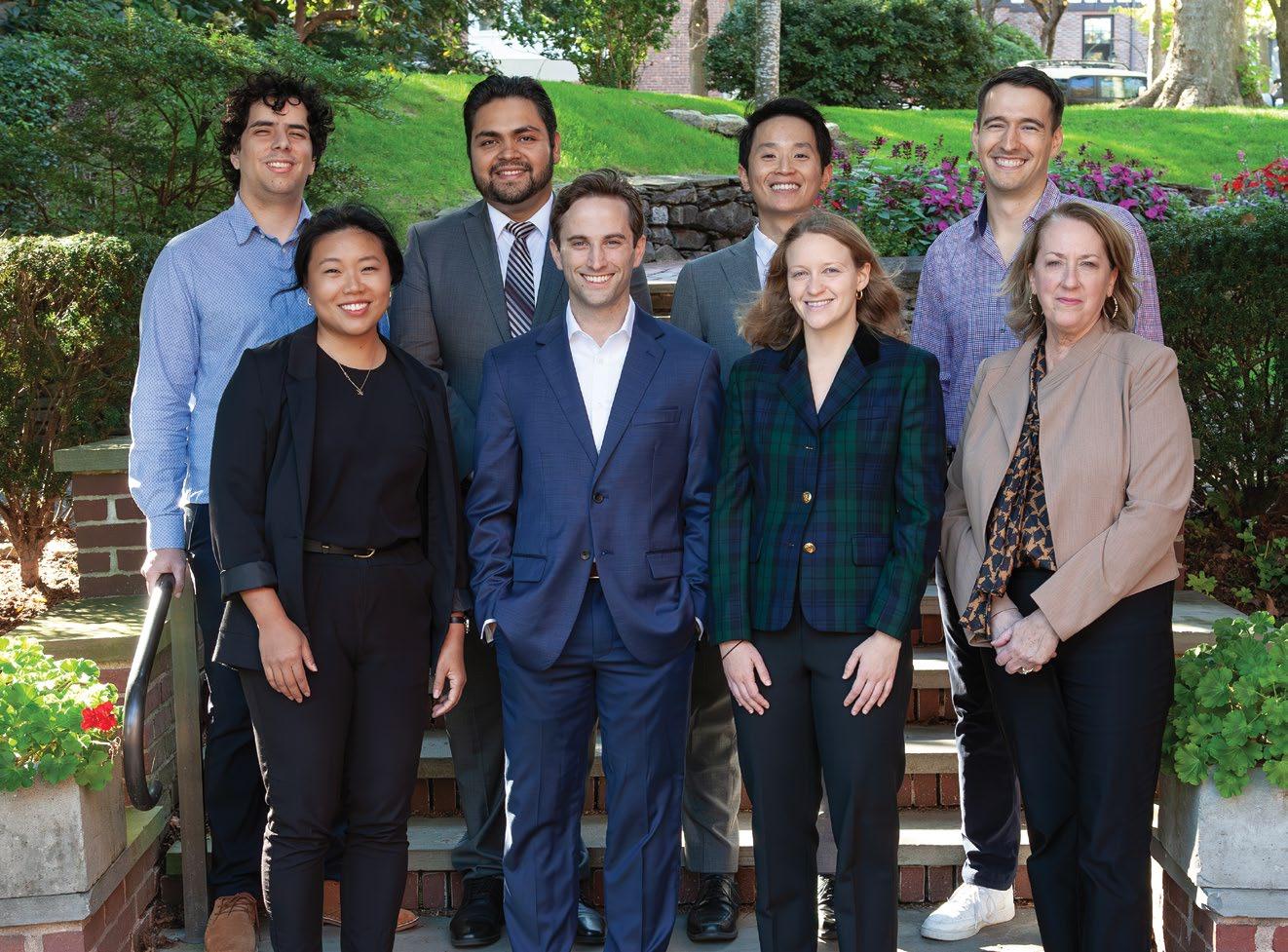
Innovation funds drive discovery in many ways. Not only are they vital to maintaining excellence in established research teams, but they are also seeds of opportunity.
From collaborative research initiatives that pass from basic through clinical realms, to discovery awards that promote commercialization, innovation funds have catalyzed cuttingedge work among faculty at all levels.
Such was the case for Katherine “Katie” Siddle, PhD, an assistant professor of molecular microbiology and immunology who came to Brown in January 2023. Siddle is interested in how pathogens (particularly viruses) emerge, spread, and evolve, and the selective pressures they place on infected hosts. Using data, experimentation, and
fieldwork, she investigates the genetic diversity of emerging viruses and the role of host and pathogen genetic variation in disease severity.
$8.5M
The Supreme Court’s 2022 Dobbs decision left a critical knowledge and skills gap for students in states with medical schools that had to stop teaching abortion care. Brown responded by expanding its complex family planning program.
Innovation funds were critical for Siddle to successfully establish interconnected teams in her lab. “Over the last year, we have officially launched the wet lab and secured our first independent funding,” she says. “I have particularly enjoyed discussing and working with several fantastic students, and am looking forward to meeting many more as we launch a new course in pathogen genomics.”
The University’s integrated life sciences research facility is a signature project in Brown’s commitment to advancing research for impact. What’s more, it will have a profound impact on the Rhode Island community.
In 2023, the Medical School welcomed its first visiting fourth-year medical student to gain experience in family planning clinics, the ob/gyn emergency department, and the operating room. Brown is also developing a division of complex family planning to expand access to reproductive health care for everyone who needs it. These efforts are complemented by local opportunities for advocacy and policymaking, which are not available in many larger states.
Philanthropic support from Mimi D. Pichey ’72 plays a meaningful role in advancing excellence in this area. From
the Women’s Reproductive Health Fund and Sexual Health Advocacy and Policy Education grants, to the establishment of the Mimi Pichey ’72 Assistant Professorship in Obstetrics and Gynecology and the Complex Family Planning Fund, Brown can champion an educational approach to better clinical care.
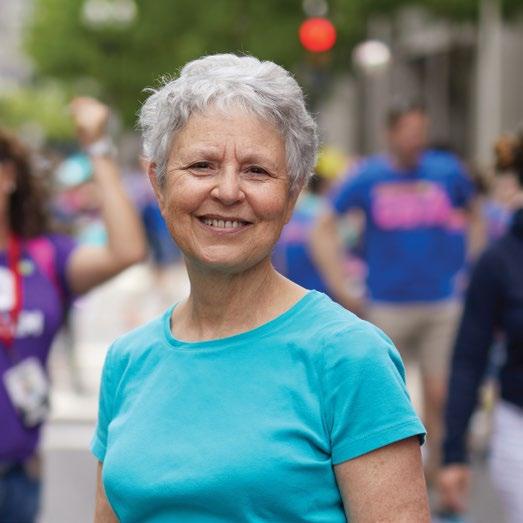
$122M
Most immediate are the construction jobs that the project, expected to take three to four years, will generate. A ground-level education lab will provide space for scientific workshops and programs for local schoolchildren and teachers. The research activity in the building will spur job and economic growth; in 2023, National Institutes
RAISED TO DATE
of Health-funded research supported more than 2,200 jobs in Rhode Island and generated more than $502 million in economic activity.
Located in the Jewelry District adjacent to existing Brown and hospital research buildings, the facility will bring a critical mass of top leaders across the biomedical sciences, engineering, computer science, and medicine to address significant problems in human health. The generous support of donors will play a critical role in making this vision a reality. They’ve provided $122 million toward the project before a shovel has even gone into the ground. Their visionary support will have transformational impact not only at Brown but on the state.

During my three-week rotation at Brown, I gained exposure to a wide range of care, and I was touched to witness the compassionate, patient-centered approach that Brown’s family planning group upheld in every patient encounter. I also greatly appreciated the mentorship I received to develop a policy brief addressing current legislation in my home state of Georgia.
– CLARA WANG

MUKESH K. JAIN, MD
Senior Vice President for Health Affairs Dean of Medicine and Biological Sciences
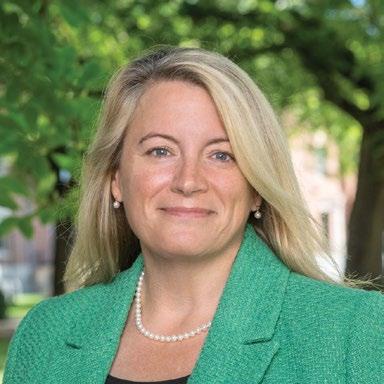
KIMBERLY A. GALLIGAN, MBA
Vice President for Clinical Affairs and Strategy and Chief Operating Officer

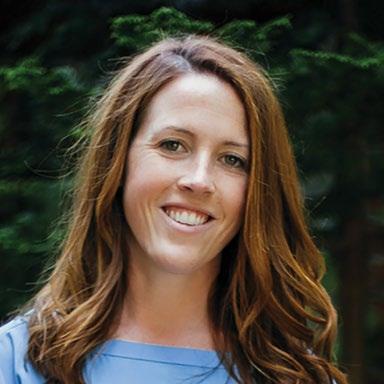
CAILIE BURNS
Senior Associate Dean and Strategic Advisor for Advancement, Biology and Medicine
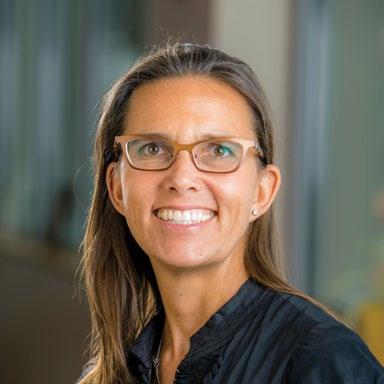
B. STAR HAMPTON, MD
Senior Associate Dean for Medical Education

MICHELE G. CYR, MD
Senior Associate Dean for Academic Affairs
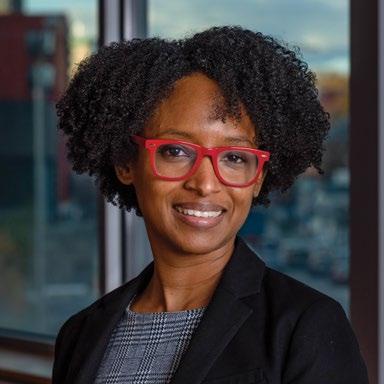
KELLY D. HOLDER, PHD Chief Wellness Officer

THOMAS ROBERTS, PHD
Senior Associate Dean for the Program in Biology
SHARON I. ROUNDS, MD
Associate Dean for Translational Science

PATRICIA POITEVIEN, MD, MSC
Senior Associate Dean for Diversity, Equity, and Inclusion

KATE F. SMITH, PHD
Senior Associate Dean of Biology Education

Office_of_Biomed_Communications@brown.edu biomed.brown.edu
Follow us: Brown University Division of Biology and Medicine Box G-A1 Providence, RI 02912, USA 401-863-3330
linkedin.com/school/warrenalpertmedicalschool

@alpertmedicalschool
facebook.com/BrownMedicine
@BrownMedicine
DESIGNED BY ORANGE SQUARE